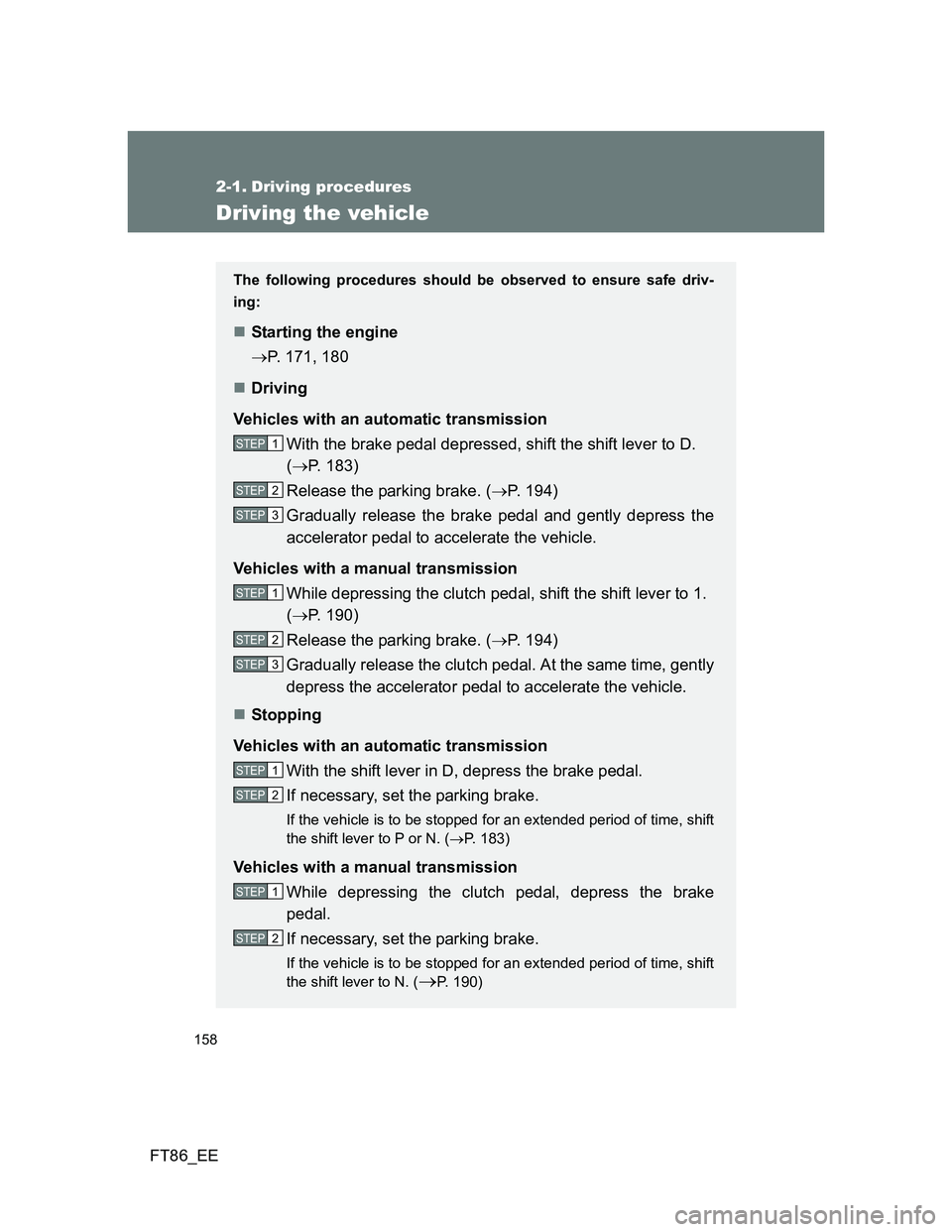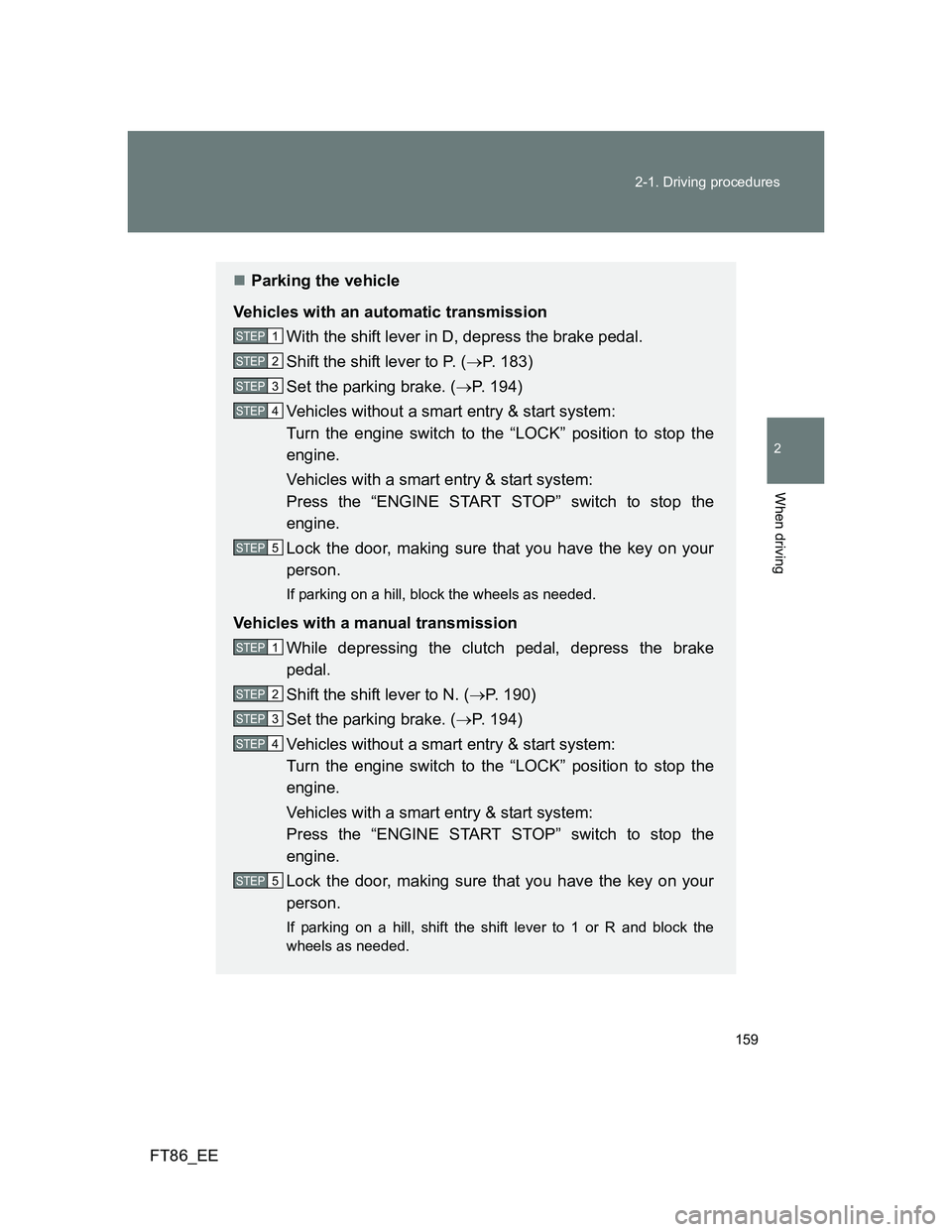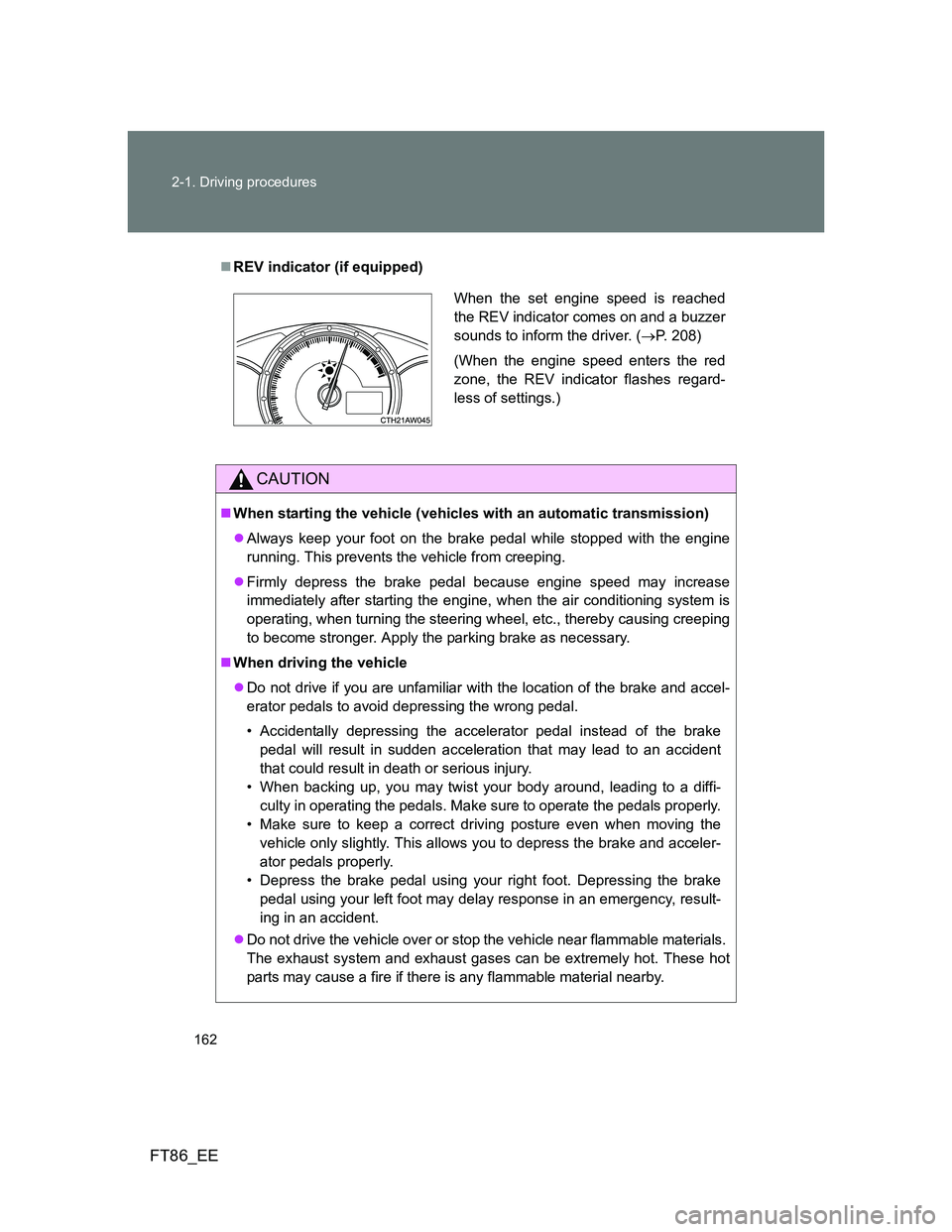Page 129 of 452

129 1-7. Safety information
1
Before driving
FT86_EE
CAUTION
SRS warning light
If the warning light exhibits any of the following conditions, there may be a
malfunction in the seat belt pretensioners and/or SRS airbag system. We
recommend that you have the system checked immediately by your nearest
any authorized Toyota dealer or repairer, or another duly qualified and
equipped professional. Unless checked and properly repaired, the seat belt
pretensioners and/or SRS airbags will operate improperly (e.g. SRS airbags
may inflate in a very minor collision or not inflate in a severe collision), which
may increase the risk of injury.
Flashing or flickering of the warning light
No illumination of the warning light when the engine switch is first turned to
the “ON” position (vehicles without a smart entry & start system), or the
“ENGINE START STOP” switch is turned to “ON” mode (vehicles with a
smart entry & start system).
Continuous illumination of the warning light
Illumination of the warning light while driving
Page 153 of 452
153
1
1-7. Safety information
Before driving
FT86_EE
Airbag manual on-off system
This system deactivates the front passenger airbag.
Only deactivate the airbags when using a child restraint system on
the front passenger seat.
Airbag manual on-off indica-
tor
Vehicles without a smart
entry & start system
This indicator light turns on
when the airbag system is on
(only when the engine switch is
in the “ON” position).
Vehicles with a smart entry &
start system
This indicator light turns on
when the airbag system is on
(only when the “ENGINE
START STOP” switch is in
IGNITION ON mode).
Airbag manual on-off switch
Page 154 of 452
154 1-7. Safety information
FT86_EE
Deactivating the front passenger airbag
Vehicles without a smart entry
& start system
Insert the key into the cylinder
and turn to the “OFF” position.
The “OFF” indicator light turns on
(only when the engine switch is in
the “ON” position).
Vehicles with a smart entry &
start system
Insert the mechanical key into
the cylinder and rotate to the
“OFF” position.
The “OFF” indicator light turns on
(only when the “ENGINE START
STOP” switch is in IGNITION ON
mode).
Page 155 of 452

155 1-7. Safety information
1
Before driving
FT86_EE
Airbag manual on-off indicator information
The front passenger’s front airbag ON and OFF indicators shows you the
status of the front passenger’s SRS front airbag. When the engine switch
is turned to the “ON” position (vehicles without a smart entry & start sys-
tem) or the “ENGINE START STOP” switch is turned to IGNITION ON
mode (vehicles with a smart entry & start system), both the ON and OFF
indicators illuminate while the system is checked, after which both indica-
tors turn off. After that, “ON” or “OFF” on the ON-OFF indicator will be
illuminated according to the position of the airbag manual on-off switch.
If any of the following problems occur, it is possible that there is a mal-
function in the system. Have the vehicle inspected by any authorized
Toyota dealer or repairer, or another duly qualified and equipped profes-
sional.
• Neither “ON” nor “OFF” comes on.
• The indicator light does not change when the airbag manual on-off
switch is switched to “ON” or “OFF”.
CAUTION
When installing a child restraint system
For safety reasons, always install a child restraint system in a rear seat. In
the event that the rear seat cannot be used, the front seat can be used as
long as the airbag manual on-off system is set to “OFF”.
If the airbag manual on-off system is left on, the strong impact of the airbag
deployment (inflation) may cause serious injury or even death.
When a child restraint system is not installed on the front passenger
seat
Ensure that the airbag manual on-off system is set to “ON”.
If it is left off, the airbag may not deploy in the event of an accident, which
may result in serious injury or even death.
Page 158 of 452

158
FT86_EE
2-1. Driving procedures
Driving the vehicle
The following procedures should be observed to ensure safe driv-
ing:
Starting the engine
P. 171, 180
Driving
Vehicles with an automatic transmission
With the brake pedal depressed, shift the shift lever to D.
(P. 183)
Release the parking brake. (P. 194)
Gradually release the brake pedal and gently depress the
accelerator pedal to accelerate the vehicle.
Vehicles with a manual transmission
While depressing the clutch pedal, shift the shift lever to 1.
(P. 190)
Release the parking brake. (P. 194)
Gradually release the clutch pedal. At the same time, gently
depress the accelerator pedal to accelerate the vehicle.
Stopping
Vehicles with an automatic transmission
With the shift lever in D, depress the brake pedal.
If necessary, set the parking brake.
If the vehicle is to be stopped for an extended period of time, shift
the shift lever to P or N. (P. 183)
Vehicles with a manual transmission
While depressing the clutch pedal, depress the brake
pedal.
If necessary, set the parking brake.
If the vehicle is to be stopped for an extended period of time, shift
the shift lever to N. (
P. 190)
STEP 1
STEP 2
STEP 3
STEP 1
STEP 2
STEP 3
STEP 1
STEP 2
STEP 1
STEP 2
Page 159 of 452

159 2-1. Driving procedures
2
When driving
FT86_EE
Parking the vehicle
Vehicles with an automatic transmission
With the shift lever in D, depress the brake pedal.
Shift the shift lever to P. (P. 183)
Set the parking brake. (P. 194)
Vehicles without a smart entry & start system:
Turn the engine switch to the “LOCK” position to stop the
engine.
Vehicles with a smart entry & start system:
Press the “ENGINE START STOP” switch to stop the
engine.
Lock the door, making sure that you have the key on your
person.
If parking on a hill, block the wheels as needed.
Vehicles with a manual transmission
While depressing the clutch pedal, depress the brake
pedal.
Shift the shift lever to N. (P. 190)
Set the parking brake. (P. 194)
Vehicles without a smart entry & start system:
Turn the engine switch to the “LOCK” position to stop the
engine.
Vehicles with a smart entry & start system:
Press the “ENGINE START STOP” switch to stop the
engine.
Lock the door, making sure that you have the key on your
person.
If parking on a hill, shift the shift lever to 1 or R and block the
wheels as needed.
STEP 1
STEP 2
STEP 3
STEP 4
STEP 5
STEP 1
STEP 2
STEP 3
STEP 4
STEP 5
Page 162 of 452

162 2-1. Driving procedures
FT86_EE
REV indicator (if equipped)
CAUTION
When starting the vehicle (vehicles with an automatic transmission)
Always keep your foot on the brake pedal while stopped with the engine
running. This prevents the vehicle from creeping.
Firmly depress the brake pedal because engine speed may increase
immediately after starting the engine, when the air conditioning system is
operating, when turning the steering wheel, etc., thereby causing creeping
to become stronger. Apply the parking brake as necessary.
When driving the vehicle
Do not drive if you are unfamiliar with the location of the brake and accel-
erator pedals to avoid depressing the wrong pedal.
• Accidentally depressing the accelerator pedal instead of the brake
pedal will result in sudden acceleration that may lead to an accident
that could result in death or serious injury.
• When backing up, you may twist your body around, leading to a diffi-
culty in operating the pedals. Make sure to operate the pedals properly.
• Make sure to keep a correct driving posture even when moving the
vehicle only slightly. This allows you to depress the brake and acceler-
ator pedals properly.
• Depress the brake pedal using your right foot. Depressing the brake
pedal using your left foot may delay response in an emergency, result-
ing in an accident.
Do not drive the vehicle over or stop the vehicle near flammable materials.
The exhaust system and exhaust gases can be extremely hot. These hot
parts may cause a fire if there is any flammable material nearby.
When the set engine speed is reached
the REV indicator comes on and a buzzer
sounds to inform the driver. (P. 208)
(When the engine speed enters the red
zone, the REV indicator flashes regard-
less of settings.)
Page 169 of 452

169 2-1. Driving procedures
2
When driving
FT86_EE
NOTICE
When driving the vehicle
Vehicles with an automatic transmission
Do not depress the accelerator and brake pedals at the same time during
driving, as this may restrain driving torque.
Do not use the accelerator pedal or depress the accelerator and brake
pedals at the same time to hold the vehicle on a hill.
Vehicles with a manual transmission
Do not depress the accelerator and brake pedals at the same time during
driving, as this may restrain driving torque.
Do not shift gears unless the clutch pedal is fully depressed. After shifting,
do not release the clutch pedal abruptly. Doing so may damage the clutch,
transmission and gears.
Observe the following to prevent the clutch from being damaged.
• Do not rest your foot on the clutch pedal while driving.
Doing so may cause clutch trouble.
• Do not use any gear other than the 1st gear when starting off and mov-
ing forward.
Doing so may damage the clutch.
• Do not use the clutch to hold the vehicle when stopping on an uphill
grade.
Doing so may damage the clutch.
Do not shift the shift lever to R when the vehicle is still moving. Doing so
may damage the clutch, transmission and gears.
Do not release the clutch pedal too quickly. Doing so may damage the
transmission.
When parking the vehicle (vehicles with an automatic transmission)
Always shift the shift lever to P. Failure to do so may cause the vehicle to
move or the vehicle may accelerate suddenly if the accelerator pedal is acci-
dentally depressed.